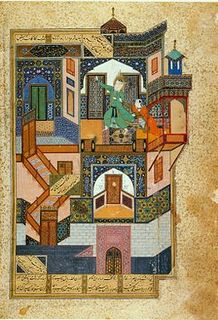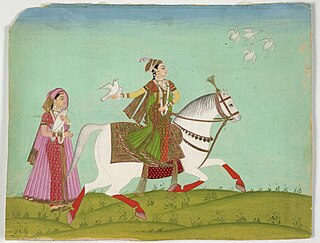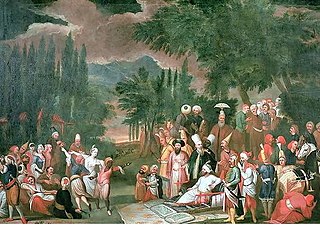
The Chester Beatty is a museum and library in Dublin. Formerly known as the Chester Beatty Library, it was established in Ireland in 1950, to house the collections of mining magnate, Sir Alfred Chester Beatty. The present museum, on the grounds of Dublin Castle, opened on 7 February 2000, the 125th anniversary of Beatty's birth and was named European Museum of the Year in 2002.

The Deccan sultanates were five late-medieval Indian kingdoms—on the Deccan Plateau between the Krishna River and the Vindhya Range—that were ruled by Muslim dynasties: namely Ahmadnagar, Berar, Bidar, Bijapur, and Golconda. The sultanates had become independent during the break-up of the Bahmani Sultanate. In 1490, Ahmadnagar declared independence, followed by Bijapur and Berar in the same year. Golconda became independent in 1518, and Bidar in 1528.

The Adil Shahi or Adilshahi, was a Shia Muslim, and later Sunni Muslim, dynasty founded by Yusuf Adil Shah, that ruled the Sultanate of Bijapur, centred on present-day Bijapur district, Karnataka in India, in the Western area of the Deccan region of Southern India from 1489 to 1686. Bijapur had been a province of the Bahmani Sultanate (1347–1518), before its political decline in the last quarter of the 15th century and eventual break-up in 1518. The Bijapur Sultanate was absorbed into the Mughal Empire on 12 September 1686, after its conquest by the Emperor Aurangzeb.

Mughal painting is a particular style of South Asian, particularly North Indian, painting confined to miniatures either as book illustrations or as single works to be kept in albums (muraqqa). It emerged from Persian miniature painting and developed in the court of the Mughal Empire of the 16th to 18th centuries. The Mughal emperors were Muslims and they are credited with consolidating Islam in South Asia, and spreading Muslim arts and culture as well as the faith.

Ibrahim Adil Shah II was king of the Sultanate of Bijapur and a member of the Adil Shahi dynasty. Under his reign the dynasty had its greatest period as he extended its frontier as far south as Mysore. He was a skilful administrator, artist, poet and a generous patron of the arts. He reverted to the Sunni sect of Islam, but remained tolerant of other religions, including Christianity. However, during his reign high-ranking Shiite immigrants became unwelcome and in 1590, he ordered the confinement of criers who read the khutba in the Shia form. After his reign, increasing weakness permitted Mughal encroachment and the successful revolt of the Maratha king Shivaji, who killed the Bijapur general Afzal Khan and scattered his army. The dynasty left a tradition of cosmopolitan culture and artistic patronage whose architectural remains are to be seen in the capital city of Bijapur.

The Siyer-i Nebi is a Turkish epic about the life of Muhammad, completed around 1388, written by Mustafa son of Yusuf of Erzurum, known as al-Darir, a Mevlevi dervish on the commission of Sultan Berkuk, the Mamluk ruler in Cairo. The text is based on a 13th-century Arabic sira by al-Bakri of the original Biography of the Prophet by al-Waqidi (748-822).

A Persian miniature is a small Persian painting on paper, whether a book illustration or a separate work of art intended to be kept in an album of such works called a muraqqa. The techniques are broadly comparable to the Western Medieval and Byzantine traditions of miniatures in illuminated manuscripts. Although there is an equally well-established Persian tradition of wall-painting, the survival rate and state of preservation of miniatures is better, and miniatures are much the best-known form of Persian painting in the West, and many of the most important examples are in Western, or Turkish, museums. Miniature painting became a significant genre in Persian art in the 13th century, receiving Chinese influence after the Mongol conquests, and the highest point in the tradition was reached in the 15th and 16th centuries. The tradition continued, under some Western influence, after this, and has many modern exponents. The Persian miniature was the dominant influence on other Islamic miniature traditions, principally the Ottoman miniature in Turkey, and the Mughal miniature in the Indian sub-continent.

Tutinama, literal meaning "Tales of a Parrot", is a 14th-century series of 52 stories in Persian. The work remains well-known largely because of a number of lavishly illustrated manuscripts, especially a version containing 250 miniature paintings was commissioned by the Mughal Emperor, Akbar in the 1550s. The Persian text used was redacted in 14th century AD from an earlier anthology ‘Seventy Tales of the Parrot’ in Sanskrit compiled under the title Śukasaptati dated to the 12th century AD. In India, parrots are popular as storytellers in works of fiction.

Bidar sultanate was one of the Deccan sultanates of late medieval southern India.

Sultana Chand Bibi was an Indian Muslim ruler and warrior. She acted as the Regent of Bijapur Sultanate and Ahmednagar Sultanate (in current day Maharashtra. Chand Bibi is best known for defending Ahmednagar against the Mughal forces of Emperor Akbar in 1595.
Ibrahim Adil Shah I (1534–1558) was a Sultan and later Shah of the Indian kingdom. of Bijapur. He succeeded his elder brother, Mallu Adil Shah, through the machinations of the Afaqi faction at the court. He was the first Adil Shahi ruler to assume the royal title of Shah.

A Muraqqa is an album in book form containing Islamic miniature paintings and specimens of Islamic calligraphy, normally from several different sources, and perhaps other matter. The album was popular among collectors in the Islamic world, and by the later 16th century became the predominant format for miniature painting in the Persian Safavid, Mughal and Ottoman empires, greatly affecting the direction taken by the painting traditions of the Persian miniature, Ottoman miniature and Mughal miniature. The album largely replaced the full-scale illustrated manuscript of classics of Persian poetry, which had been the typical vehicle for the finest miniature painters up to that time. The great cost and delay of commissioning a top-quality example of such a work essentially restricted them to the ruler and a handful of other great figures, who usually had to maintain a whole workshop of calligraphers, artists and other craftsmen, with a librarian to manage the whole process.

History of the Turkic peoples between 6th and 14th centuries. Although the chronology of the Seljuq Sultanate of Rûm is covered in this timeline, for a more detailed timeline for the Seljuq Sultanate of Rûm see Timeline of the Seljuq Sultanate of Rûm. For a timeline of the modern Turkish state and its legal predecessor see Timeline of the Ottoman Empire and Timeline of Turkish history. Beyond what is described in this timeline, Turkic peoples have lived outside of the Ottoman Empire and Turkey, such as in Azerbaijan and the Central Asian republics of former USSR as well as Russia, China, Iran, Afghanistan, Pakistan & India.

The Turk Jamat are a Muslim community found in India. Many members of Turk Jamat Muslim community migrated to Pakistan after the independence in 1947 and settled in Karachi.

Ali Barid Shah I was the third ruler of the Barid Shahi dynasty. He succeeded his father in 1540, and ruled until his death in 1580. He was considered a man of letters, and invited scholars and craftsmen from all over the Indian subcontinent to his capital. He is also known to have played a key logistical role in the Battle of Talikota.

The Shahnameh of Shah Tahmasp or Houghton Shahnameh is one of the most famous illustrated manuscripts of the Shahnameh, the national epic of Greater Iran, and a high point in the art of the Persian miniature. It is probably the most fully illustrated manuscript of the text ever produced. When created, the manuscript contained 759 pages, 258 of which were miniatures. These miniatures were hand painted by the artists of the royal workshop in Tabriz under rulers Shah Ismail I and Shah Tahmasp I. Upon its completion, the Shahnameh was gifted to Ottoman Sultan Selim II in 1568. The page size is about 48 x 32 cm, and the text written in Nastaʿlīq script of the highest quality. The manuscript was broken up in the 1970s and pages are now in a number of different collections around the world.

Deccan painting or Deccani painting is the form of Indian miniature painting produced in the Deccan region of Central India, in the various Muslim capitals of the Deccan sultanates that emerged from the break-up of the Bahmani Sultanate by 1520. These were Bijapur, Golkonda, Ahmadnagar, Bidar, and Berar. The main period was between the late 16th century and the mid-17th, with something of a revival in the mid-18th century, by then centred on Hyderabad.

Murtaza Nizam Shah II was the Sultan of Ahmadnagar from 1600 to 1610. His rule was dominated by the powerful regent Malik Ambar, under whom he was an effective puppet ruler.
Turkic peoples have historically been associated as one of the non-indigenous peoples to have ruled areas of the Indian subcontinent. Modern day Turkish people in India, on the other hand, are very small in number, and are recent immigrants from Turkey. In the 1961 census, 58 people stated that their mother tongue was Turkish. According to the 2001 census, 126 residents of India stated their place of birth as Turkey. In a state visit during early 2010, Prime Minister Abdullah Gül of Turkey met Turkish expatriates living in India and handed out Hindi-Turkish dictionaries to Turkish students in New Delhi.














